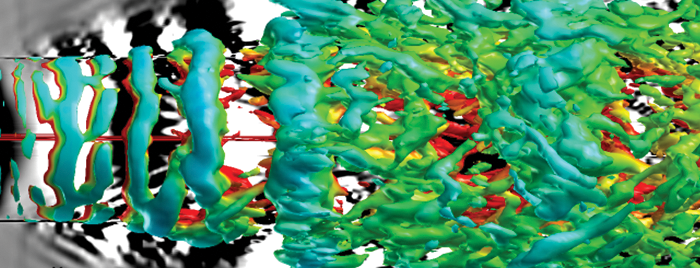The noise from jet-engine exhausts can cause substantial hearing loss for crewmen and airport personnel and activate restrictive regulations and/or fees for airlines. The large turbulent eddies within the jet plume—also known as large-scale coherent structures—produce the majority of the noise in the aft angles of the engine. However, the process by which these eddies generate noise is not well understood.
To gain insight into the noise-generation process, computational results from The Ohio State University’s High Fidelity Computational Multi-Physics Lab (HFCMPL) are being coupled with experimental results from Ohio State’s Aerospace Research Center (ARC). Plasma actuators at the jet exit are triggered at specific frequencies to create consistent large-scale coherent structures. This localization allows researchers to study the interaction of these structures with the surrounding air and the resulting noise signature.
Datta Gaitonde, Ph.D., a professor of mechanical and aerospace engineering at The Ohio State University, and his team, are modeling excited jets using Large Eddy Simulations—a high-fidelity method of simulating time-accurate turbulent airflow—by leveraging the computing power of the Ohio Supercomputer Center’s Ruby and Oakley Clusters.
“Our computational studies reproduced the experimental data very accurately,” said Gaitonde. “But the real advantage of numerical results lies in their extraordinarily detail, which allows us to scrutinize the complex process by which coherent structures are generated and disintegrated to produce noise. This cannot be done in live experiments due to the invasive nature of measuring techniques that can obtain three-dimensional spatio-temporally resolved data.”
Recent computations have shown that the large-scale turbulent structures generated by the actuators are highly correlated to the near field i.e., the region immediately outside of the jet plume. Interactions between successive structures are quasi-linear and thereby result in a quasi-linear superposition of the resulting sound.
“Currently, to be able to further analyze the noise-generation process, we are focusing on the decomposition of the near field into acoustic components and non-noise fluctuations, also called hydrodynamic components,” said Rachelle Speth, a graduate student working on the study with Gaitonde at HFCMPL. “This insight should aid in the development of revolutionary new control strategies.”
Current interests of researchers at HFCMPL include jet noise, shock wave-turbulent boundary-layer interactions, scramjet flow paths in hypersonic flight and flows past wings.
Project Lead: Datta Gaitonde, Ph.D., The Ohio State University
Research Title: Near field pressure and associated coherent structures of excited jets
Funding Source: Air Force Office of Scientific Research
Website: hfcmpl.osu.edu

